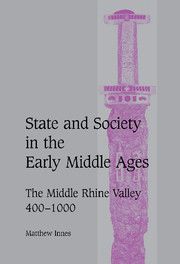Book contents
- Frontmatter
- Contents
- List of figures
- List of abbreviations
- A note on nomenclature and citations
- Acknowledgements
- Map 1 The Carolingian Rhineland
- Map 2 The Carolingian middle Rhine valley
- 1 INTRODUCTION
- 2 MONASTICISM, SPIRITUAL PATRONAGE AND SOCIAL STRUCTURE
- 3 LAND, KINSHIP AND STATUS
- 4 LOCAL POWER: COLLECTIVE ACTION, CONFLICT AND CONSENSUS
- 5 LOCALITY AND CENTRE: MECHANISMS OF EXTRACTION
- 6 POLITICAL POWER FROM THE FIFTH TO THE ELEVENTH CENTURY
- 7 CONCLUSION: STATE AND SOCIETY IN THE EARLY MEDIEVAL WEST
- List of primary sources
- Bibliography of secondary works
- Index
- Cambridge Studies in Medieval Life and Thought Fourth series
7 - CONCLUSION: STATE AND SOCIETY IN THE EARLY MEDIEVAL WEST
Published online by Cambridge University Press: 10 July 2009
- Frontmatter
- Contents
- List of figures
- List of abbreviations
- A note on nomenclature and citations
- Acknowledgements
- Map 1 The Carolingian Rhineland
- Map 2 The Carolingian middle Rhine valley
- 1 INTRODUCTION
- 2 MONASTICISM, SPIRITUAL PATRONAGE AND SOCIAL STRUCTURE
- 3 LAND, KINSHIP AND STATUS
- 4 LOCAL POWER: COLLECTIVE ACTION, CONFLICT AND CONSENSUS
- 5 LOCALITY AND CENTRE: MECHANISMS OF EXTRACTION
- 6 POLITICAL POWER FROM THE FIFTH TO THE ELEVENTH CENTURY
- 7 CONCLUSION: STATE AND SOCIETY IN THE EARLY MEDIEVAL WEST
- List of primary sources
- Bibliography of secondary works
- Index
- Cambridge Studies in Medieval Life and Thought Fourth series
Summary
STRUCTURAL CHARACTERISTICS OF EARLY MEDIEVAL POLITIES
We need to identify the peculiarities of the middle Rhenish experience before attempting comparison and generalisation. The middle Rhine valley was a region whose geopolitical profile underwent a series of dramatic changes between the late Roman period and the high middle ages, changes which affected the relationship of the region to the political centre. In this Roman frontier province political power was transformed by the Imperial infrastructure, which led to the foundation of fortified settlements as the central points of local society, an influx of men and resources in the army, and, in the fourth century, the physical proximity of the Emperor. Eventually, in the fifth century, the middle Rhine found itself cut off from the redistributive system of the Roman army and administration. A new power structure, which expressed itself in the idiom of a ‘frontier culture’ which had developed through the interaction of barbarian elites and the Roman military, had emerged by the sixth century. The change from Roman to post-Roman, the atrophy of institutionalised forms of power and the emergence of militarised rule which tapped the agrarian surplus directly, was far more abrupt here than elsewhere in Gaul. By 600, rulers began once again to be involved in the region directly; rulers based, as they had been in the fourth century, in northern Gaul, but increasingly interested in exploitation of the ‘wild east’, the provinces beyond the Rhine, and happy to stay at Worms and Mainz.
- Type
- Chapter
- Information
- State and Society in the Early Middle AgesThe Middle Rhine Valley, 400–1000, pp. 251 - 267Publisher: Cambridge University PressPrint publication year: 2000

